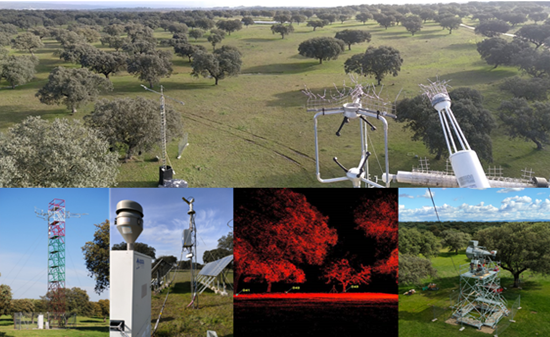The Majadas de Tiétar ecosystem station has been measuring water vapor (H2O) and carbon dioxide (CO2) fluxes continuously since 2003. It is located in the province of Cáceres (Extremadura), in a holm oak (Quercus Ilex) savanna (dehesa), a typical example of an agrosylvopastoral system, which is of great economic and social importance in the Iberian Peninsula, both for its surface area and for its function of maintaining the rural population in its settlements. The European Union recognised in 1992 (by means of Council Directive 92/43/EEC), the uniqueness of this impressive plant formation, being catalogued as a natural habitat. It extends over more than 3.5 million hectares and is mainly concentrated in the southwest of the Iberian Peninsula.
The experimental station is located in a typical savanna with an open holm oak forest and a lower substrate of grassland composed of herbaceous species with high biodiversity. The holm oaks are approximately 100 years old, with a 20% canopy cover fraction and a density of 22 holm oaks per hectare. The holm oak is one of the most widespread species in southern Europe and, without doubt, the most representative of the entire Iberian Peninsula.
The Majadas de Tiétar ecosystem station started in 2003 with the installation by the CEAM Foundation of a 15 m. "Eddy Covariance" flux tower in the framework of the European project CarboEurope-IP. Over the years, the experimental station implemented a complex long-term systematic observation programme, based on systems for measuring CO2, H2O and energy fluxes by the eddy covariance technique, complemented by hundreds of sensors of various types for monitoring meteorological variables (atmospheric pressure, air temperature and humidity, precipitation, wind speed, global, diffuse, shortwave and longwave, incident and reflected radiation), and environmental variables (soil temperature and humidity profiles, soil heat fluxes, tree temperature).
The data provided by the station are of particular relevance for the estimation of certain current ecosystem services, such as carbon sequestration, water use or the regulation of hydrological flows. Water availability being the main factor limiting the productivity of Mediterranean ecosystems, the interactions between carbon cycle and water cycle are crucial to study the sensitivity and vulnerability of the carbon balance of these ecosystems, and therefore of their productivity, to climate change. The data have also been used for the calibration and validation of remote sensing products, as well as for the adjustment and validation of several models (global climate models, Soil-Vegetation-Atmosphere exchange models, complex biogeochemical and ecological models). The relevance of the studies carried out on the basis of the experimental data from the Majadas de Tiétar station is reflected in the significant scientific output, with more than one hundred scientific articles published in international SCI journals, including around 50 in which CEAM Foundation researchers participate.

